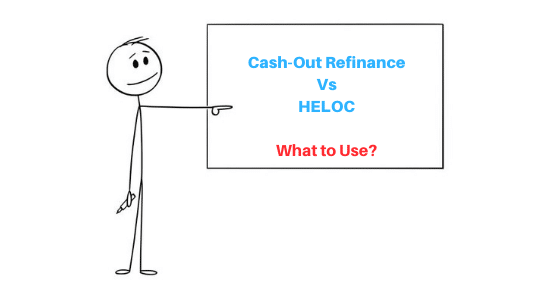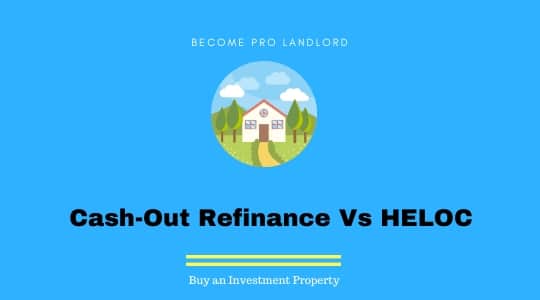Cash Out Refinance Vs HELOC To Buy an Investment Property
The Best part of buying real estate is that you can slowly build equity in it. And then use this equity further to buy more income-generating Real Estate. How do you do it? Either you use a cash-out refi or pull out a HELOC against the equity you built in your current property. But, now the real question. Which is better among Cash-Out Refinance Vs HELOC to tap into existing equity? Even most savvy investors are looking for the same answer.
So, If you are also buying an investment property for yourself and confused between a HELOC Vs Cash-Out Refinance. We got the answer for you. So, sit back and relax. Lots of details coming for you in this article. You are going to be buying an investment property for yourself after all.
What is a Cash-Out Refinance?
Cash-Out Refinance is refinancing an existing mortgage to pull out the equity, you have built over the time in your current property.
Suppose you have a mortgage on your current property of $280,000 on which, say, only $200,000 amount is pending now. You have bought this property in 2015 for $350,000 and due to appreciation, your property is worth $400,000 now in five years.
This means that you have built $200,000 ($400,000 minus $200,000) equity in your current property. Now you can do a cash-out refinance on your existing mortgage. Instead of the $200,000, you can now refinance your existing property for a new mortgage worth $400,000.
However, the lender never lends for 100% value and instead, you will get only about 80% funding. So, now you will get a cash-out refinanced mortgage of $320,000 (80% of $400,000). Out of $320,000; $200,000 will be sent towards closing your old mortgage. And the remaining $120,000, the lender will give you in cash.
After doing a Cash-out refi, you will now have a new mortgage of $320,000 on your existing property. And $120,000 in cash to buy another investment property.
What is a HELOC?
A HELOC or Home Equity Line of Credit is a credit limit that you obtain against the equity in your existing property.
With a HELOC, you are obtaining a second mortgage in which the lender lends you a credit limit which you can use according to your need. Let us again take the above example, where you have built $200,000 in equity in your existing property.
Now if you take out a HELOC against this property, the lender will let you borrow up to 85% of $200,000 via a line of credit depending upon your creditworthiness and debt to income ratio. In a nutshell, you basically are getting a credit card of say X limit which you can use according to your need.
Do You know your Credit Score?
A Typical Difference Between Cash-Out Refinance Vs HELOC

Though, the purpose of a Cash-Out Refinance and HELOC is the same where you pull out equity from an existing property. But these two have various considerable differences which drastically impacts how much money you pay over a long period for pulling out equity from your existing property.
So, it becomes important that you choose between Cash-out refinance vs HELOC wisely.
Furthermore, if you put these two to comparison, you will find out that on some fronts a Cash-Out Refinance seems better than a HELOC. And on some fronts, HELOC feels better. So which one of these between the two is better for your goal?
At a glance,
- With a Cash-Out Refinancing, you are changing the terms of your existing mortgage by swapping it for a new mortgage.
- However, with a HELOC, you are obtaining a second mortgage while keeping your first mortgage as it is in place.
As I said, sometimes it is Cash-out Refi that scores points, and sometimes it is HELOC. So, it is better we put these under the light of Pros and Cons. And, then decide what is better among the two?
Cons with Cash-Out Refinance
- There can be a chance that your existing mortgage already has better terms (like fewer interest rates). And, when you refinance, you will not get these better terms with the new mortgage.
- You might only need some money for the downpayment to buy another investment property. But, with cash-out refinance, it is not possible to get only what is required. There is a chance you occur in a situation where you finance excess money which is no use to you. Cash-Out Refinance lacks flexibility.
- Financing an investment property, you pay about 3%-5% in closing costs, and cash-out refinancing is no exception. No matter you have paid closing costs already on your existing loan. But when you refinance, you again got hit by closing costs.
Pros of Cash-Out Refinance
- With cash-out refinance, you have a chance to lower down your interest rates or switch to better terms if you are not satisfied with the terms of your current mortgage.
- A Cash-out refinance allows you to have one monthly mortgage, unlike a HELOC which has two separate payments.
Cons Of HELOC
- HELOCs are not fixed amounts of loans, instead of a revolving credit line. As it is revolving, there are chances that your lender reduces or even freezes your credit line if in any way your credit score gets a hit. Even one late or missed mortgage payment can mess your credit score.
- With HELOC, the interest rates can go up and down anytime. The rates are variable and keep on adjusting. This can cause you with clouds of uncertainty. You are never sure exactly how much you owe the next month. If you are a person like me who budgets for everything, having an uncertain monthly payment can be a real pain in the ass.
“Get one step ahead and set a monthly track of your Credit Score”
Pros Of HELOC
- HELOCs are flexible credit lines that you can use according to your needs. There is no risk of over-leveraging unlike with the Cash-out Refinance.
- Some lenders may allow you to make interest-only payments on the borrowed amount. You can repay the principal amount later at the end of the term of the mortgage. It can be an advantage for some but in the long run, you will be paying a huge amount in interest.
Cash-Out Refinance Vs HELOC: Head to Head
| Cash Out Refinance | HELOC | |
|---|---|---|
| Maximum Borrowing Limit | 80% LTV | 85% LTV |
| Interest Rates | 3.75%-4.25% (can be fixed and adjustable) | 3.15%-5.32% (Variable Rate can go up to 21%) * |
| Maximum Tenure | Up to 30 Years | Up to 20 Years |
| Closing Costs | 2%-6% of Loan Amount | Low Closing Costs (Most Lenders even waive off the closing fees) |
| Minimum Credit Score | 620 or higher | 620 or higher |
| Debt To Income Ratio | No more than 50% | No more than 43% |
| Risk | Comparatively less risk | High Risk due to uncertain mortgage payments and variable high interest rates |
Cash-Out Refinance Vs HELOC: What to Use?
Before you scratch your head between Cash-Out Refinance vs HELOC, let us tell you what will be the best choice for your case.

→Use HELOC only in cases
- You have an existing mortgage whose term is already best and you think refinancing it is causing a higher interest rate.
- When you need only a small amount of money and you think cash-out refinancing will put you at risk of over-leveraging.
- You need to use the money for a very short time.
Except for these three cases, a cash-out refinance is your best bet any day and the reasons are obvious.
How Cash-Out Refinance is Better to Tap into Existing Equity?
- You will have a fixed mortgage payment every month.
- The more is the time to repay your mortgage, the better it is. And with cash-out refinance, you are getting 30 years. Though, you can always repay faster if you want. (Read: Pay Off Mortgage or Re Invest the Cash Flow)
- You might pay a higher closing cost on a cash-out refinance but that is worth considering a high and variable interest rate on using a HELOC.
Also, a Cash-Out Refinance outweighs HELOC, as there are some pitfalls with a HELOC. These pitfalls are basically conditions that vary from lender to lender. And you must confirm them beforehand.
- Minimum Withdrawal: There can be a cap on the withdrawal amount where you have to withdraw at least a minimum set by the lender.
- Inactivity Fees: There can be an inactivity fee if you don’t use your line of credit after a certain time period.
- Early Termination Fees: If you terminate your line credit early, you pay an early termination fee.
- Pre Payment Penalties: It is not always possible with a HELOC to close the loan early. And to do so, there can be pre-payment penalty charges.
- Annual Maintenance Fees: No matter whether you use your credit line or not, there is an annual maintenance or membership fee to keep your credit line available to you anytime you want it.
The Bottom Line
Now you have it all between a Cash-Out Refinance Vs HELOC. From the above, you can understand that the cash-out refinance is a better choice over a HELOC. Though you may be impressed with the flexibility of a HELOC. But that flexibility can cost you lots of dollars. So, choose wisely and invest well. All the best for your next purchase.
Further, if you got any concerns related to the topic. We are listening and our comment box is here to serve you.
Also, if you haven`t yet joined our Facebook Group; today is the best time to do it. We are a growing community of Landlords and budding investors grinding hard to achieve financial freedom through Rental Properties.


